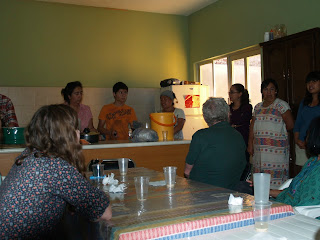Most families shared similar stories of migrating north. Some went as kids only to be deported to places they have no connection to as young adults. Some went for 20 years or more then came back to care for elders or were deported. Some found ways to go with documents, but that is terribly expensive. It is clear that there was a long history of movement back and forth across the border. Both countries thought little of it until 1) NAFTA began destroying the rural economy and 2)September 11 intensified a focus on sealing the border and criminalizing undocumented migration.
 |
| Charlie spoke of the pain of deportation, forcing him to leave behind two daughters and returning him to a place he had left when he was a small boy. |
 |
| Women from the collective in the front row. |
In 2006 they decided to do a project for the community. Concerned about the impact on their health by the wood stoves in the kitchen, they worked with a student from Oregon to build ecofriendly stoves and toilets. In a year they did 30 stoves.
In 2007 they decided to place trash bins on Main Street with an awareness-raising message on them. At first there was resistance, then support from the town. The bins are still in place and the town now has added more.
 |
| One of the recycling bins near the market place. |
Next was a project of care baskets for older women without children. Again, their small project grew beyond their dreams.
In 2009 they decided to tackle reforestation, beginning in a small way with the 30 trees they could afford. (tree cutting, both by local people and by timber companies has and a bad impact on the ecosystem.) Because much of the land is held in common, they had to go to the town government to ask permission for where to plant their trees. The council decided that this was a good project and that to protect the trees, everyone needed to be involved. They required a community service day for the preparing of the land and the planting. In the end 600 trees were planted and a fence built around it to,protect the small trees from grazing animals. They created a committee to care for the trees, so that they get watered every day in the dry season. Young people caught drinking too much or in other trouble may be sent to care for the trees as a way of repairing their relations with the community.
Food is a chronic problem. In a community without a lot of cash, growing your own food is a good idea. In 2011 they began a project to help people grow small gardens both to feed their families and to sell extras in the local market. They have held workshops helping people learn what they need to know food.
All of this has played a role in changing the possibilities for women in the community. Women play a more active role in the community assemblies. More girls are staying in school for longer times, and young women have access to information about health issues and domestic violence. They have ways of selling the stunning woven tapestries they make, as well as other handcrafts. And when there is more economic security, there is less need to migrate.
It was a deeply complex visit, full of both inspiration and the sadness so families pulled apart by migration and deportation. And great beauty in the physical setting and in the crafts.
We returned today in time to see a huge (500-800 people) march through Oaxaca, ending at the nearby zocalo, of teachers, teachers in training and students protesting privatization of education, the closing of the community college (which is free, making education accessible to indigenous youth from the villages)and other education "reforms". Their energy and creativity was great! Slogan of the day "Revolution is not an act of rebellion- it is an action for justice!".






